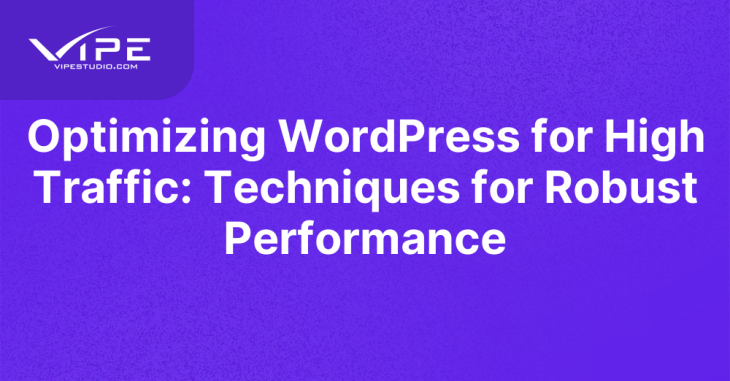Optimizing WordPress for High Traffic: Techniques for Robust Performance

READING TIME: MIN
Optimizing WordPress for High Traffic: Techniques for Robust Performance
WordPress's popularity as a content management system (CMS) stems from its user-friendly interface, extensive plugin ecosystem, and flexibility. However, as a website's traffic grows, maintaining optimal performance becomes crucial to ensure a seamless user experience and prevent slowdowns or crashes. In this article, our enterprise wordpress agency for custom development will talk about the techniques for optimizing WordPress to handle high traffic efficiently, ensuring robust performance even under heavy loads.
Choose a Reliable Hosting Provider:
The foundation of a high-performing WordPress site is a reliable hosting provider that can handle spikes in traffic without compromising speed or uptime. Consider opting for managed WordPress hosting or a dedicated server that offers scalable resources and performance optimization features such as caching, content delivery networks (CDNs), and server-level optimizations.

Implement Caching Mechanisms:
Caching is a key technique for reducing server load and speeding up page load times. WordPress plugins like WP Super Cache, W3 Total Cache, or WP Rocket enable caching of dynamic content, HTML files, and database queries, resulting in faster page rendering for returning visitors and reduced server resource usage during traffic spikes.
Optimize Images and Media Files:
Large images and media files can significantly impact page load times, especially for mobile users with limited bandwidth. Use image optimization tools or plugins to compress images without sacrificing quality, lazy loading techniques to defer loading off-screen images until they are needed, and content delivery networks (CDNs) to serve images from geographically distributed servers for faster delivery.
Minimize HTTP Requests:
Each HTTP request made by a web browser adds overhead to page load times. Minimize the number of HTTP requests by combining CSS and JavaScript files, using sprites for image assets, and reducing the number of external scripts and plugins loaded on each page. Tools like GTmetrix or Pingdom can help identify and optimize excessive HTTP requests.

Enable Gzip Compression:
Gzip compression reduces the size of web page files transferred between the server and the browser, resulting in faster page load times and reduced bandwidth usage. Most modern web servers support Gzip compression, and WordPress plugins like WP Rocket or W3 Total Cache offer options to enable Gzip compression with a single click.
Optimize Database Performance:
WordPress relies on a MySQL or MariaDB database to store content, settings, and other site data. Optimize database performance by regularly cleaning up unused data, optimizing database tables, and implementing database caching mechanisms. Plugins like WP-Optimize or WP Sweep automate database optimization tasks and ensure efficient database performance.
Use Content Delivery Networks (CDNs):
CDNs cache static content like images, CSS files, and JavaScript files on servers located strategically around the world, reducing latency and improving page load times for visitors across different geographic locations. Integrate your WordPress site with a CDN provider like Cloudflare, Akamai, or Amazon CloudFront to leverage their global network infrastructure and enhance performance.

Monitor and Analyze Performance:
Regular monitoring and analysis of website performance metrics are essential for identifying bottlenecks, tracking performance trends, and making informed optimization decisions. Utilize tools like Google PageSpeed Insights, GTmetrix, or New Relic to monitor key performance indicators such as page load times, server response times, and resource utilization, and take proactive steps to address any issues.
Best in Market: Our Enterprise wordpress agency for custom development
Ready to kick your website up a notch? Well, you're in luck because our enterprise WordPress agency for custom development is here to save the day! Picture this: you've got a killer idea for your site, but you're not quite sure how to bring it to life. That's where our enterprise wordpress agency for custom development comes in. We're not your average agency—we're all about custom solutions tailored just for you. Whether you're a small business or a big player in the game, our enterprise wordpress agency for custom development got the skills and expertise to make your website dreams a reality. So why settle for off-the-shelf solutions when you can have something totally unique? Let's ditch the cookie-cutter templates and build something awesome together. Trust me, you won't regret teaming up with our enterprise WordPress agency for custom development. Let's make magic happen!
Conclusion:
Optimizing WordPress for high traffic requires a combination of strategic planning, technical expertise, and ongoing monitoring and optimization efforts. By implementing techniques such as caching, image optimization, minimizing HTTP requests, and leveraging content delivery networks (CDNs), businesses can ensure robust performance and seamless user experiences even under heavy traffic loads. Additionally, regularly monitoring performance metrics and making data-driven optimization decisions enables organizations to continuously improve their WordPress sites' performance and responsiveness, ensuring that they can handle high traffic efficiently and maintain a competitive edge in the digital landscape.


